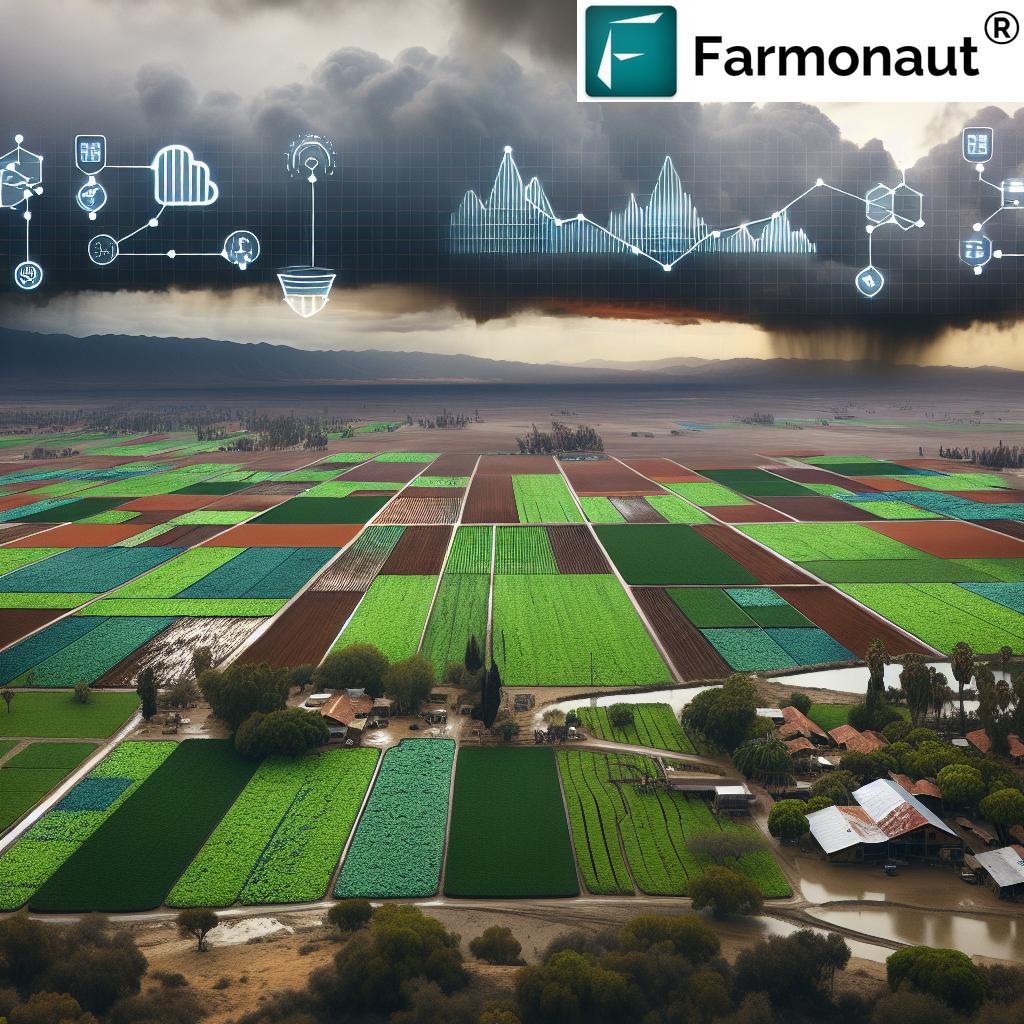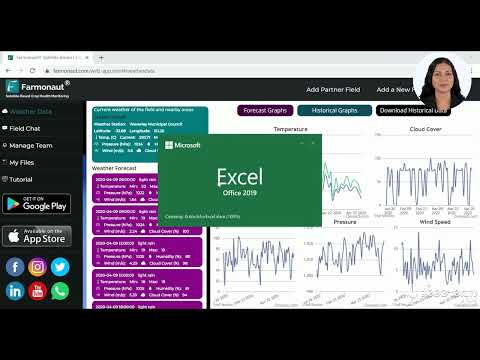El Niño’s Impact on US Crop Health: Weather Forecasts and Precision Farming Strategies
“El Niño is expected to increase rainfall by up to 30% in the Midwest, particularly along the Mississippi River valley.”
As we delve into the intricate relationship between El Niño and US crop health, we find ourselves at the forefront of a critical juncture in agricultural management. The impending El Niño weather impact on agriculture is set to reshape our growing season forecast, presenting both challenges and opportunities for farmers across the nation. In this comprehensive analysis, we’ll explore how climate change and crop yields are interconnected, and how precision agriculture technologies can help navigate these complex weather patterns.
Understanding El Niño and Its Agricultural Implications
El Niño, a climate phenomenon characterized by warmer-than-average sea surface temperatures in the eastern Pacific Ocean, has far-reaching effects on global weather patterns. For the United States, particularly the agricultural sector, El Niño brings a host of changes that can significantly impact crop health and productivity.
- Increased rainfall in certain regions
- Shifts in temperature patterns
- Alterations in the length and timing of growing seasons
- Changes in pest and disease prevalence
These factors collectively influence the agricultural landscape, necessitating adaptive strategies and innovative farming approaches. At Farmonaut, we recognize the importance of staying ahead of these climate-driven changes. Our satellite-based crop health monitoring systems provide real-time data that enables farmers to make informed decisions in the face of El Niño’s impacts.

The Science Behind El Niño and Crop Health
To truly understand the impact of El Niño on US agriculture, we must first examine the scientific principles at play. The phenomenon’s influence on atmospheric circulation patterns leads to significant changes in temperature and precipitation across different regions of the country.
Rainfall Patterns and Soil Moisture
One of the most notable effects of El Niño is its impact on rainfall distribution. The Midwest, particularly along the Mississippi River valley, often experiences increased precipitation during El Niño years. This can lead to:
- Higher soil moisture levels
- Potential for flooding in low-lying areas
- Changes in nutrient leaching and soil composition
Our Farmonaut platform utilizes advanced satellite imagery to monitor these changes in soil moisture, providing farmers with crucial data for irrigation management and flood risk assessment. By accessing our API, agricultural professionals can integrate this vital information directly into their existing farm management systems.
Temperature Fluctuations and Crop Development
El Niño also brings about changes in temperature patterns, which can significantly affect crop development stages. Warmer temperatures may lead to:
- Earlier spring planting dates
- Accelerated crop growth in some regions
- Potential heat stress during critical growth stages
Our Jeevn AI Advisory System takes these temperature fluctuations into account, providing personalized recommendations for planting dates and crop selection based on the latest El Niño forecasts.
Regional Impact of El Niño on US Agriculture
The effects of El Niño are not uniform across the United States. Different regions experience varying impacts, which necessitates tailored approaches to agricultural management. Let’s break down the expected effects across key agricultural areas:
| Agricultural Factors | Midwest | Southeast | Southwest | Northwest |
|---|---|---|---|---|
| Rainfall | High | Medium | Low | Medium |
| Temperature | Medium | High | High | Low |
| Crop Yield Potential | Medium | Low | Low | Medium |
| Flooding Risk | High | Medium | Low | Low |
| Drought Relief | High | Medium | Medium | Low |
Midwest: Navigating Excess Moisture
The Midwest, America’s breadbasket, is particularly susceptible to El Niño’s influence. With increased rainfall expected, farmers in this region must be prepared for:
- Potential delays in spring planting due to wet field conditions
- Increased risk of fungal diseases in crops like corn and soybeans
- Possible nutrient leaching from excessive rainfall
Our satellite-based crop health monitoring tools can help Midwest farmers identify areas of standing water and assess soil moisture levels, enabling timely interventions to protect crop health.
Southeast: Managing Heat and Humidity
In the Southeast, El Niño typically brings warmer and drier conditions. This can lead to:
- Increased irrigation needs for crops
- Higher risk of heat stress for plants
- Potential shifts in pest populations
Farmonaut’s precision agriculture technologies, including our variable rate fertilizer application tools, can help farmers in this region optimize resource use and mitigate the effects of heat stress on crops.
“Warm air rising in hot air balloons can reach altitudes of 5,000 to 10,000 feet, similar to thunderstorm formation processes.”
Southwest: Drought Management Strategies
The Southwest often experiences drier conditions during El Niño years, exacerbating existing drought concerns. Farmers in this region should focus on:
- Efficient water management through advanced irrigation systems
- Drought-resistant crop varieties
- Soil conservation practices to retain moisture
Our agricultural irrigation systems recommendations, powered by real-time satellite data, can help Southwest farmers make the most of limited water resources.
Northwest: Adapting to Cooler, Wetter Conditions
The Northwest may see cooler and wetter weather during El Niño events. This can result in:
- Delayed crop maturation due to cooler temperatures
- Increased disease pressure in fruits and vegetables
- Potential for improved water availability for irrigation
Farmonaut’s crop health monitoring services can help Northwest farmers track plant development and identify potential disease outbreaks early, allowing for timely interventions.

Leveraging Precision Agriculture Technologies in El Niño Years
As we navigate the challenges posed by El Niño, precision agriculture technologies become invaluable tools for farmers. These advanced solutions allow for targeted interventions and data-driven decision-making, crucial for maintaining crop health and optimizing yields in variable weather conditions.
Satellite-Based Crop Monitoring
Satellite imagery provides a comprehensive view of crop health across vast areas. During El Niño years, this technology becomes even more critical:
- Early detection of stress areas in fields
- Monitoring of crop development stages
- Assessment of flood or drought impacts
Farmonaut’s satellite-based crop health monitoring system offers farmers real-time insights into their fields’ conditions, enabling proactive management strategies.
AI-Driven Weather Forecasting
Accurate weather forecasting is crucial for agricultural planning, especially during El Niño years. AI-powered models can:
- Provide hyper-local weather predictions
- Forecast potential extreme weather events
- Assist in long-term seasonal planning
Our Jeevn AI Advisory System incorporates these advanced weather forecasts to deliver tailored recommendations for farm management practices.
Variable Rate Technology
Variable rate application of inputs becomes particularly important when dealing with the uneven field conditions often caused by El Niño weather patterns:
- Optimized fertilizer application based on soil moisture levels
- Targeted irrigation to address varying water needs across fields
- Precise pest and disease management in affected areas
Farmonaut’s platform supports variable rate fertilizer application by providing detailed field maps and prescription recommendations based on real-time crop health data.
Strategies for Mitigating El Niño’s Impact on Crop Health
With the challenges of El Niño clearly defined, let’s explore specific strategies that farmers can employ to protect and enhance crop health during these weather events.
Adaptive Planting Schedules
Adjusting planting dates can help mitigate the risks associated with El Niño-induced weather changes:
- Earlier planting in regions expecting drier conditions
- Delayed planting in areas prone to spring flooding
- Staggered planting to spread risk across the growing season
Our AI-driven advisory system can provide personalized recommendations for optimal planting dates based on local climate predictions and historical data.
Water Management Techniques
Efficient water management is crucial during El Niño years, whether dealing with excess rainfall or drought conditions:
- Implementation of drainage systems in flood-prone areas
- Adoption of water-conserving irrigation methods in drier regions
- Use of cover crops to improve soil water retention
Farmonaut’s satellite imagery can help identify areas of poor drainage or drought stress, allowing for targeted water management interventions.
Integrated Pest Management
El Niño can alter pest populations and disease pressures, necessitating a robust integrated pest management (IPM) approach:
- Regular monitoring for new or increased pest pressures
- Use of resistant crop varieties when possible
- Timely application of targeted pest control measures
Our crop health monitoring tools can help detect early signs of pest infestations or disease outbreaks, enabling prompt and effective IPM strategies.
Soil Health Preservation
Maintaining soil health is critical for resilience against El Niño’s impacts:
- Implementation of conservation tillage practices
- Use of cover crops to prevent erosion and improve soil structure
- Regular soil testing and balanced nutrient management
Farmonaut’s platform includes soil health assessment tools that can guide farmers in implementing these crucial soil preservation strategies.
Leveraging Data for Informed Decision-Making
In the era of precision agriculture, data-driven decision-making is key to navigating the challenges posed by El Niño. Farmonaut’s comprehensive suite of tools provides farmers with the insights they need to make informed choices throughout the growing season.
Real-Time Crop Monitoring
Our satellite-based crop monitoring system offers:
- Daily updates on crop health status
- Early detection of stress factors
- Comparative analysis with historical data
By leveraging this information, farmers can respond quickly to emerging issues and optimize their management practices.
Weather Data Integration
Accurate weather forecasting is crucial for agricultural planning, especially during El Niño years. Our platform integrates:
- Short-term and seasonal weather forecasts
- Historical climate data for trend analysis
- Alerts for extreme weather events
This comprehensive weather data helps farmers make informed decisions about planting, irrigation, and harvest timing.
Predictive Analytics for Yield Optimization
Our AI-powered predictive analytics tools help farmers:
- Forecast potential yields based on current conditions
- Identify areas for yield improvement
- Optimize resource allocation for maximum productivity
These insights enable farmers to make data-driven decisions that can significantly impact their bottom line, even in challenging El Niño years.
Conclusion: Embracing Resilience in the Face of El Niño
As we navigate the complexities of El Niño’s impact on US crop health, it’s clear that the intersection of weather forecasts and precision farming strategies is more crucial than ever. By leveraging advanced technologies and data-driven insights, farmers can not only mitigate the risks associated with changing climate patterns but also uncover new opportunities for optimizing crop yields and resource management.
At Farmonaut, we’re committed to providing the tools and expertise needed to thrive in this dynamic agricultural landscape. Our comprehensive platform, from satellite-based crop monitoring to AI-driven advisory services, empowers farmers to make informed decisions that protect crop health and enhance productivity, regardless of the challenges posed by El Niño or other climate phenomena.
As we look to the future, the resilience and adaptability fostered by precision agriculture technologies will be key to ensuring food security and sustainable farming practices in the face of changing global weather patterns. By staying informed, leveraging cutting-edge tools, and embracing innovative strategies, US farmers can turn the challenges of El Niño into opportunities for growth and improvement.
FAQs
Q: How does El Niño affect crop yields in the United States?
A: El Niño can have varied effects on crop yields across different regions of the US. It typically leads to increased rainfall in the Midwest and Southern states, which can benefit some crops but may also increase the risk of flooding. In contrast, it often brings drier conditions to the Northern states, potentially leading to drought stress for crops in those areas.
Q: Can precision agriculture technologies help mitigate the impacts of El Niño?
A: Yes, precision agriculture technologies play a crucial role in mitigating El Niño’s impacts. Tools like satellite-based crop monitoring, AI-driven weather forecasting, and variable rate application systems help farmers make data-driven decisions to optimize resource use and protect crop health in changing weather conditions.
Q: How does Farmonaut’s platform assist farmers during El Niño years?
A: Farmonaut’s platform provides real-time crop health monitoring, personalized farm advisory through our Jeevn AI system, and advanced weather data visualization tools. These features help farmers adapt their strategies to El Niño conditions, optimize resource use, and make informed decisions throughout the growing season.
Q: What are some key strategies for managing crop health during El Niño?
A: Key strategies include adjusting planting schedules, implementing efficient water management techniques, adopting integrated pest management practices, and focusing on soil health preservation. Utilizing data-driven insights from precision agriculture technologies is also crucial for adapting to El Niño conditions.
Q: How can farmers access Farmonaut’s services?
A: Farmers can access Farmonaut’s services through our web application, mobile apps for Android and iOS, or by integrating our API into their existing farm management systems. We offer flexible subscription options to suit various farm sizes and needs.
For more information on integrating our services into your farming operations, please visit our API Developer Docs.






